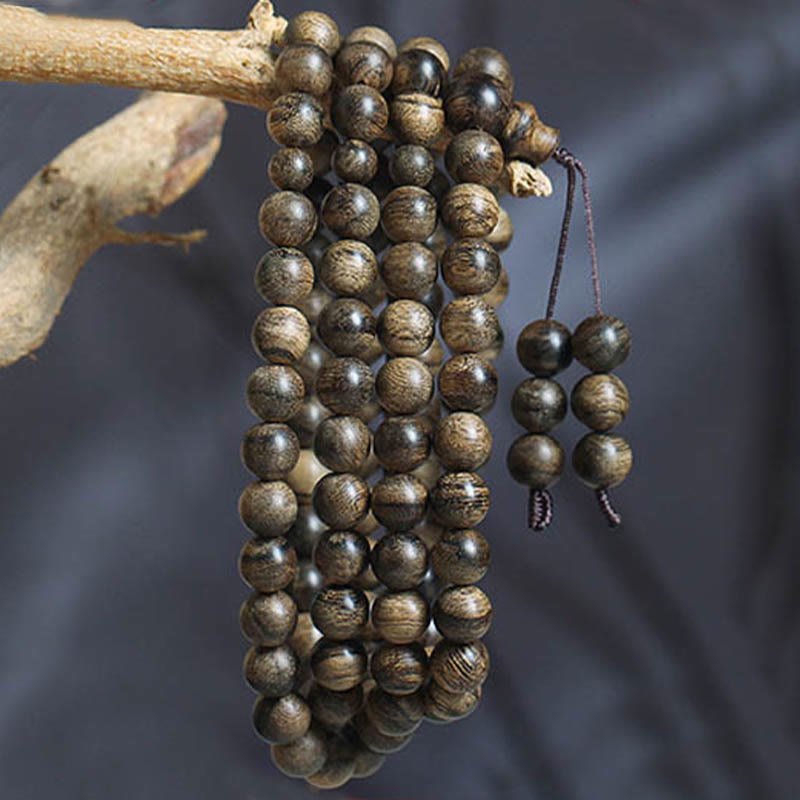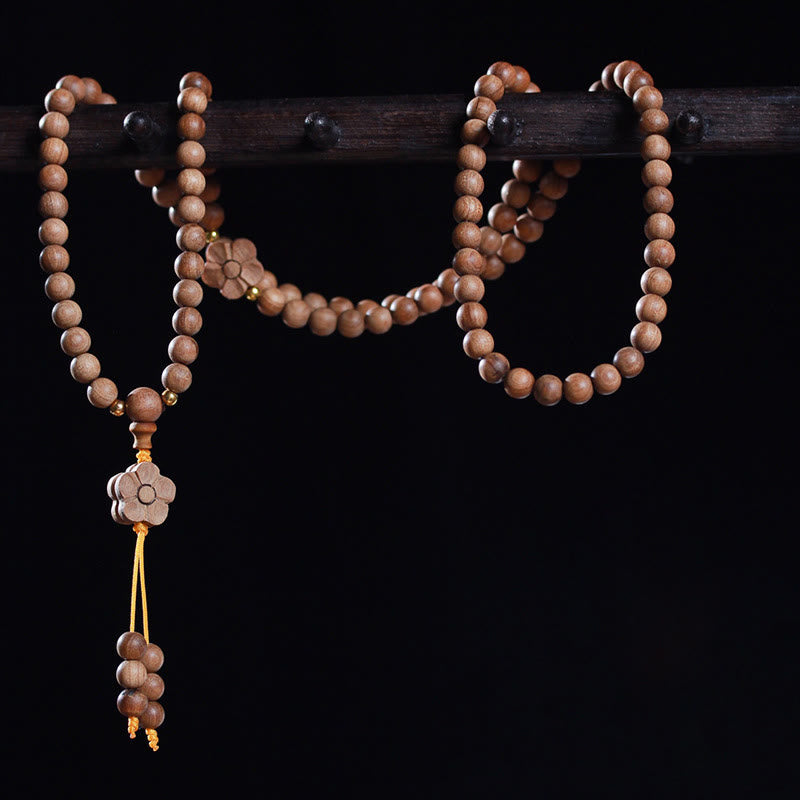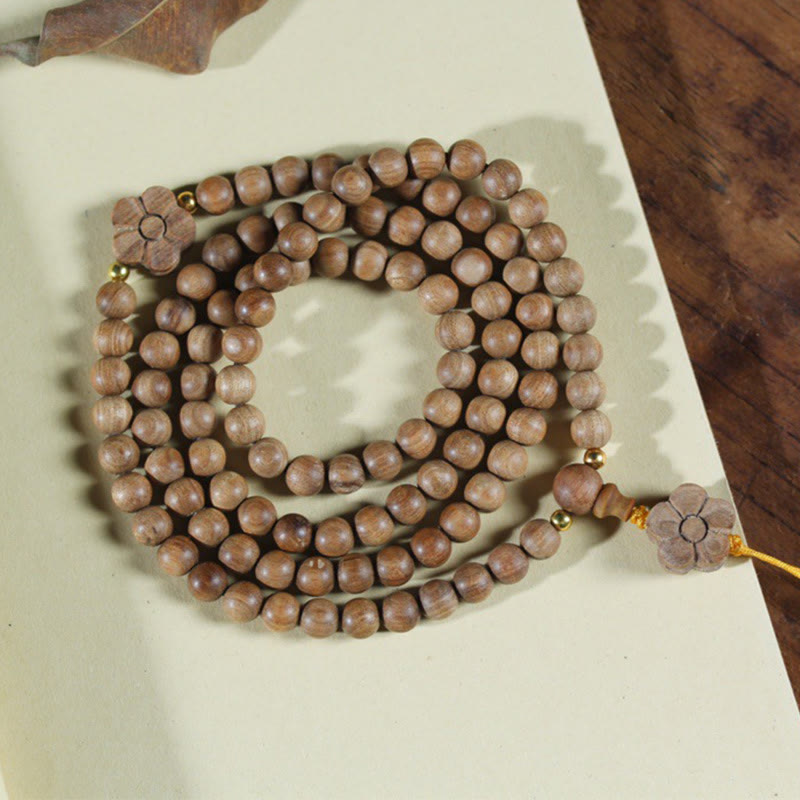Eine Reise der Achtsamkeit kann sowohl aufregend als auch überwältigend sein. Wenn Sie Ihre spirituelle Praxis vertiefen und Ihre Sitzungen greifbarer machen möchten, könnte die Meditation mit Mala-Perlen das erdende Werkzeug sein, nach dem Sie gesucht haben. Diese wunderschönen Perlenketten sind mehr als nur Schmuck; sie sind uralte Instrumente, die den Geist zentrieren, die Seele beruhigen und Sie mit Ihren Absichten verbinden. Egal, ob Sie neu in der Meditation sind oder Ihre bestehende Routine bereichern möchten, dieser Leitfaden führt Sie durch alles, was Sie über die Verwendung von Mala-Perlen für Meditation und Gebet wissen müssen.
In diesem Artikel entdecken Sie die einfachen und doch tiefgreifenden Techniken für die Verwendung einer Mala, von der Festlegung Ihrer Absicht bis zum abschließenden Moment der Besinnung. Wir erkunden die Struktur dieser heiligen Perlen und zeigen Ihnen einen Schritt-für-Schritt-Prozess, den Sie noch heute anwenden können, um eine fokussiertere und friedlichere Praxis zu entwickeln.
Was sind Mala-Perlen und warum werden sie zur Meditation verwendet?
Mala-Perlen, auch Japa-Perlen genannt, sind eine Kette aus 108 Perlen, die traditionell in spirituellen Praktiken wie dem Hinduismus und Buddhismus zum Beten und Meditieren verwendet werden. Die Zahl 108 gilt aus vielen Gründen als heilig und symbolisiert spirituelle Vollendung. Eine traditionelle Mala enthält außerdem eine Guru-Perle, die 109. Perle, und eine Quaste. Die Guru-Perle markiert den Anfangs- und Endpunkt des Meditationszyklus, während die Quaste unsere Verbindung zum Göttlichen und zueinander symbolisiert.
Der Hauptzweck der Verwendung von Mala-Perlen zur Meditation besteht darin, Mantras, Gebete oder Affirmationen zu zählen. Diese als Japa-Meditation bekannte Praxis beinhaltet das Rezitieren eines Mantras für jede der 108 Perlen. Die rhythmische Bewegung Ihrer Finger über die Perlen bietet einen taktilen Anker, der Ihre Gedanken vor dem Abschweifen bewahrt und Sie in einen tieferen Zustand der Bewusstheit und Ruhe sinken lässt. Jedes Material, von Sandelholz bis Türkis, trägt seine eigene einzigartige Energie, sodass Sie eine Mala wählen können, die Ihren persönlichen Absichten entspricht.

Die Bühne bereiten: Vorbereitung auf Ihre Mala-Meditation
Bevor Sie mit Ihrer Praxis beginnen, ist es wichtig, eine förderliche Umgebung zu schaffen. Die Vorbereitung signalisiert Ihrem Geist und Körper, dass es Zeit ist, langsamer zu werden und sich nach innen zu wenden. Dazu gehört die Auswahl der richtigen Hilfsmittel, die Suche nach einem ruhigen Ort und die Klärung Ihres Fokus für die Sitzung.
Wählen Sie Ihre Mala
Die Auswahl einer Mala ist ein persönlicher und intuitiver Prozess. Verschiedenen Materialien werden unterschiedliche heilende Eigenschaften und Energien zugeschrieben. Beispielsweise kann eine türkisfarbene Mala die Kommunikation und spirituelle Einstimmung fördern, während Sandelholz für sein beruhigendes und erdendes Aroma bekannt ist. Überlegen Sie, was Sie in Ihrer Praxis fördern möchten – sei es Frieden, Schutz oder Klarheit – und wählen Sie eine Mala, die diesem Ziel entspricht. Die türkisfarbene 7-Chakra-Mala-Halskette ist eine ausgezeichnete Wahl, um Ihre Energiezentren auszugleichen und Ihre meditative Konzentration zu vertiefen.
Einen ruhigen Ort finden und ein Ziel festlegen
Suchen Sie sich einen bequemen und ruhigen Ort, an dem Sie ungestört sind. Setzen Sie sich entspannt hin, entweder auf ein Kissen auf dem Boden oder auf einen Stuhl, mit gerader, aber nicht steifer Wirbelsäule. Schließen Sie die Augen und atmen Sie ein paar Mal tief durch, um Ihre Mitte zu finden. Bevor Sie beginnen, setzen Sie sich ein Ziel oder wählen Sie ein Mantra für Ihre Praxis. Ein Ziel ist ein Leitprinzip für Ihre Meditation, z. B. „Ich bin ruhig und in Frieden“. Ein Mantra ist ein Wort oder ein Laut, der wiederholt wird, um die Konzentration zu fördern, wie z. B. „Om“ oder ein Satz wie „Ich bin würdig“. Dieser erste Schritt ist entscheidend, da er Ihrer Praxis Richtung und Bedeutung verleiht.
So verwenden Sie Mala-Perlen: Eine Schritt-für-Schritt-Anleitung für Anfänger
Sobald Sie Ihren Raum vorbereitet und Ihre Absicht festgelegt haben, können Sie mit der Meditation mit Mala-Perlen beginnen. Diese einfache, rhythmische Übung ist für Anfänger leicht zu erlernen und kann eine tiefgreifende erdende Erfahrung sein. Folgen Sie diesen Schritten, um Ihre Reise zu beginnen.
- Halten Sie Ihre Mala richtig: Halten Sie Ihre Mala in der rechten Hand (in manchen Traditionen wird die rechte Hand mit Geben und die linke mit Empfangen assoziiert). Lassen Sie die Perlen über Ihren Mittelfinger fallen. Mit dem Daumen bewegen Sie sich von einer Perle zur nächsten. Der Zeigefinger gilt als Symbol des Egos, daher sollten Sie die Perlen während der Meditation nicht mit ihm berühren.
- Beginnen Sie mit der Guru-Perle: Beginnen Sie mit der Perle neben der Guru-Perle (der größeren, zentralen Perle). Halten Sie sie sanft zwischen Daumen und Mittelfinger. Atmen Sie tief ein und aus.
- Rezitiere dein Mantra: Halte die erste Perle und rezitiere dein gewähltes Mantra laut oder leise. Ziehe bei jeder Wiederholung des Mantras mit deinem Daumen die nächste Perle zu dir heran und gehe zur nächsten über.
- Fahren Sie mit allen 108 Perlen fort: Setzen Sie diesen Vorgang fort, atmen Sie tief durch und rezitieren Sie Ihr Mantra für jede der 108 Perlen. Das körperliche Gefühl, die Perlen durch Ihre Finger gleiten zu lassen, hilft Ihnen, präsent und konzentriert zu bleiben. Sollten Ihre Gedanken abschweifen, lenken Sie sie sanft zurück zum Klang und Gefühl des Mantras und der Perlen.

Dieser Prozess erzeugt einen meditativen Rhythmus, der das Nervensystem beruhigt. Das folgende Video bietet eine klare und einfache Anleitung zur visuellen Demonstration der Technik.
- Die Guru-Perle erneut erreichen: Wenn Sie die Guru-Perle erreichen, haben Sie einen vollständigen Zyklus mit 108 Wiederholungen abgeschlossen. Sie können hier für einen Moment der Besinnung und Dankbarkeit innehalten. Wenn Sie weitermeditieren möchten, überqueren Sie die Guru-Perle nicht. Drehen Sie stattdessen die Mala um und gehen Sie in die entgegengesetzte Richtung zurück.
Diese Übung ist eine wunderbare Möglichkeit, Achtsamkeit in Ihren Alltag zu integrieren. Die folgende Infografik bietet eine kurze visuelle Zusammenfassung dieser Schritte, um Ihnen den Ablauf zu verdeutlichen.

Tipps zur Vertiefung Ihrer Mala-Meditationspraxis
Wenn Sie mit der Verwendung von Mala-Perlen vertrauter werden, können Sie Ihre Praxis vertiefen. Beständigkeit ist wichtiger als Dauer, daher können schon wenige Minuten täglich einen erheblichen Einfluss haben. Hier sind einige Tipps, um Ihre Erfahrung zu verbessern:
- Pflegen Sie Ihre Perlen: Behandeln Sie Ihre Mala mit Respekt und Sorgfalt. Bewahren Sie sie an einem besonderen Ort auf, wenn Sie sie nicht benutzen, und vermeiden Sie, dass sie den Boden berührt. Dies würdigt ihre Rolle als heiliges Werkzeug.
- Aktivieren Sie Ihre Mala: Vor dem ersten Gebrauch können Sie Ihre Mala aktivieren oder aufladen. Dazu reinigen Sie sie (z. B. mit Salbeirauch oder indem Sie sie ins Sonnen-/Mondlicht legen) und legen eine klare, kraftvolle Absicht für ihre Verwendung fest. Dieses Ritual erfüllt die Perlen mit Ihrer persönlichen Energie. Detailliertere Methoden finden Sie in der Forschung von Institutionen wie dem Mindful Awareness Research Center der UCLA, die Kontext zu zielgerichteten Praktiken liefern.
- Üben Sie Beständigkeit: Versuchen Sie, jeden Tag zur gleichen Zeit zu meditieren, um eine beständige Gewohnheit zu entwickeln. Diese Regelmäßigkeit trainiert Ihren Geist und Körper, leichter in einen meditativen Zustand zu gelangen.
- Anwendung bei Angstzuständen: Wenn Sie sich ängstlich fühlen, kann es Trost spenden, einfach Ihre Mala zu halten und tief durchzuatmen. Sie können auch einen Zyklus Japa-Meditation mit einem beruhigenden Mantra wie „Ich bin sicher“ durchführen, um Ihr Nervensystem zu beruhigen.
Die Einbeziehung spezieller Hilfsmittel in Ihre Praxis kann ebenfalls für Konzentration und Erdung sorgen. Verschiedene Hölzer und Steine bieten einzigartige Energien, die Ihre Meditationsziele unterstützen.
Verbessern Sie Ihre Praxis mit diesen heiligen Werkzeugen
$3,709.99
$4,699.99
Erleben Sie uralte Weisheit und Erdung mit dieser authentischen Mala aus Adlerholz mit 108 Perlen für konzentriertes Üben. Mehr erfahren ➔
$39.90
$57.90
Fördern Sie Ruhe und Klarheit während der Mala-Meditation mit diesem aromatisch beruhigenden Sandelholzarmband mit 108 Perlen. Mehr erfahren ➔
Abschluss
Meditation mit Mala-Perlen ist eine zeitlose Praxis, die auf einfache und zugleich kraftvolle Weise Konzentration, Frieden und spirituelle Verbundenheit fördert. Als taktiler Begleiter kann eine Mala Ihre Meditation von einer abstrakten Übung in ein fundiertes, bewusstes Ritual verwandeln. Wir hoffen, dieser Leitfaden für Anfänger hat Sie bestärkt, Ihre eigene Reise mit diesen heiligen Werkzeugen zu beginnen. Seien Sie beim Lernen geduldig und mitfühlend mit sich selbst. Ihre Praxis ist eine persönliche Entdeckungsreise.
Sind Sie bereit, den perfekten Begleiter für Ihre Praxis zu finden? Entdecken Sie unsere kuratierte Sammlung authentischer Mala-Perlen bei Healing Sounds und entdecken Sie ein Werkzeug, das mit Ihrem Geist in Resonanz tritt und Sie auf Ihrem Weg zur inneren Ruhe unterstützt.
Häufig gestellte Fragen zur Meditation mit Mala-Perlen
Um mit Mala-Perlen zu meditieren, setzen Sie sich bequem hin und halten Sie die Mala in Ihrer rechten Hand, die über Ihren Mittelfinger hängt. Beginnen Sie mit der Perle neben der Guru-Perle. Ziehen Sie jede Perle mit Ihrem Daumen zu sich heran, während Sie für jede Perle ein Mantra rezitieren. Wiederholen Sie diesen Vorgang für alle 108 Perlen, bis Sie wieder die Guru-Perle erreichen, die das Ende eines Zyklus markiert.
Um ihre Heiligkeit zu bewahren, sollten Sie einige Dinge vermeiden. Berühren Sie die Perlen nicht mit Ihrem Zeigefinger , da dieser das Ego repräsentiert. Vermeiden Sie, dass Ihre Mala den Boden berührt. Es ist auch üblich, andere nicht mit Ihrer Mala in Berührung kommen zu lassen, da sie Ihre persönliche Energie und Ihre Absichten absorbiert. Behandeln Sie sie als heiliges Werkzeug, nicht nur als Schmuck.
Mala-Perlen sind ein Hilfsmittel, das bei der Meditation und beim Gebet hauptsächlich zum Zählen von Mantras, Atemzügen oder Affirmationen in Gruppen von 108 verwendet wird. Diese als Japa-Meditation bezeichnete Praxis nutzt das taktile Gefühl der Bewegung von Perle zu Perle, um den Geist konzentriert, ruhig und präsent zu halten und ihn vor dem Abschweifen während der Meditation zu bewahren.
Durch die Aktivierung deiner Mala verleihst du ihr deine persönliche Intention. Reinige die Perlen zunächst, indem du sie mit Salbei befeuchtest oder sie einige Stunden im Sonnen- oder Mondlicht liegen lässt. Halte die Mala dann in deinen Händen, schließe die Augen und lege eine klare Intention oder widme ihr ein Mantra. Trage die Mala einen Tag lang, damit sie sich auf deine Energie einstimmt.
Mala-Perlen können ein wirksames Mittel zur Bewältigung von Ängsten sein. Wählen Sie ein beruhigendes Mantra, wie zum Beispiel „Ich bin ruhig“ oder „Auch das wird vorübergehen“. Setzen Sie sich an einen ruhigen Ort und beginnen Sie mit der Japa-Meditation. Die Kombination aus rhythmischer Atmung, Mantra-Wiederholung und dem erdenden Tastgefühl der Perlen kann das Nervensystem beruhigen und Ihren Fokus von ängstlichen Gedanken auf den gegenwärtigen Moment lenken.





